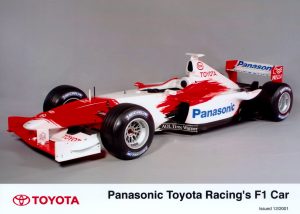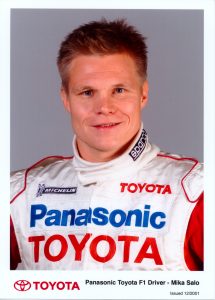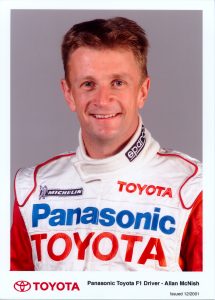Panasonic Toyota Racing Unveils 2002 Contender
Toyota has taken a significant step on its path to Formula 1 with the unveiling in Cologne of its definitive 2002 challenger, the TF102. Official drivers, Mika Salo and Allan McNish, will give the car its race debut at the Australian GP in Melbourne on 3 March.
Panasonic Toyota Racing’s F1 car, TF102, is a successor to the team’s 2001 test car, TF101, and comes with a brand new livery. The car retains Toyota’s corporate colours of red and white, and now carries the logos of the team’s newly acquired partners AOL Time Warner and Wella.
Panasonic Toyota Racing is one of only two teams to produce its own chassis and engine under one roof, and is the first new entrant to do so since 1979. It is also the first Japanese manufacturer to compete in its own right since 1968.
Over 30 countries are represented amongst the 550 employees at the team’s base in Cologne, making Toyota truly a ‘United Nations’ of F1.
Tsutomu Tomita, Chairman of Toyota Motorsport and Managing Director of Toyota Motor Corporation in Japan, said: “We are extremely pleased to make Toyota’s first ever race car debut today. Though we have only just climbed over one of many hurdles we will face during our F1 challenge, we want to share the joy and excitement of the completion of the car with all our partners and Toyota members.”
Toyota Motorsport President Ove Andersson is also extremely proud of the job everyone in the organisation has achieved as it prepares for the enormous challenge that F1 represents.
“I think our main target for next year will be to learn, and to try to gain respect within the F1 paddock,” says Andersson. “We want to be a team that at the end of next year everybody will say, ‘They came, and we think they did a reasonable job.’ That’s my target for the first year.”
The new car has been designed by a team led by Chief Designer Gustav Brunner, who joined Toyota in May, and overseen by Technical Manager of the chassis department, Dago Röhrer. The 2002 contender incorporates the lessons learned from this season’s intensive testing programme.
The engine programme is managed by Norbert Kreyer, who has had the job of designing and developing the Toyota V10 from scratch.
Since the launch of its test car in March 2001, the team has visited 11 of the current F1 venues worldwide, in addition to Toyota’s home testing base at Paul Ricard in France. In the eight-month period to November 2001, the test cars had clocked up 20,967 kilometres or over 3,000 laps.
In 2002, Panasonic Toyota Racing will test with the new TF102, initially at Circuit Paul Ricard. The team also plans to participate in a joint test scheduled in Barcelona and will have its very first run with other teams.
Toyota Motorsport has been based in Cologne since 1979, and the facility was formerly the site of the company’s World Rally Championship and Le Mans programmes. It is the only F1 team to be based in, and build an entire car in Germany.
The team’s base was recently expanded from 18,000 to 30,000 square metres as the F1 project got into gear and now incorporates the most sophisticated equipment available, allowing the team to build and develop the majority of components in-house. The floor space is split 60:40 between the chassis and engine departments.
DRIVER PROFILES
MIKA SALO
- Nationality: Finnish
- Born: 30th November 1966, Helsinki – Finland
- Lives: London, UK
- Marital Status: Married to Noriko, 1 son (Max, born 10 August 2001)
- Height: 1.75m
- Weight: 69kg
- Hobbies and Interests: Snowboarding, Mountain Biking, Playing Guitar
Mika Salo jumped at the opportunity to be centrally involved with Toyota in 2001, as an entirely new Formula 1 team was developed over a year’s intensive testing. Mika was excited by Toyota’s strategy for technical excellence. He moved quickly when offered the chance to contribute his own Formula 1 experience to the project.
Mika proved his tremendous all-round ability in the 1999 season when he stood in for Ferrari’s injured Michael Schumacher for six races. Of special importance was his drive at Hockenheim, where he comfortably led the German Grand Prix before moving over to allow his team-mate, Eddie Irvine, who was a title contender, to take the maximum points score. Then, on Ferrari’s home ground at Monza, Mika produced another solid drive to earn third place. These were his first podium finishes in Formula 1.
Throughout 2001 Mika embarked on a rigorous testing programme with Toyota. Along with Allan McNish, Mika travelled round the world with the Toyota team acquiring invaluable circuit data from Grand Prix circuits, as well as developing the team’s prototype F1 car at Circuit Paul Ricard.
Mika Salo is now ready to rejoin F1 with the Panasonic Toyota Racing team and with a renewed sense of determination he is eager to push forward the Toyota F1 project in the team’s maiden season.
ALLAN MCNISH
- Nationality: British
- Born: 29 December 1969, Dumfries, Scotland
- Lives: Warfield, UK
- Marital Status: Single
- Height: 1.65m
- Weight: 58kg
- Hobbies and Interests: Water-skiing, sport in general
Allan McNish was in the midst of a successful professional career in sports-prototype racing when he was made an irresistible offer to become a development driver for the Toyota Formula 1 project.
The Scot showed all the hallmarks of Formula 1 talent as a young racer, yet has never started a Grand Prix. He won honour after honour in the ‘junior’ single-seater divisions, progressing from Formula Ford via Formula 3 to the FIA Formula 3000 Championship. When he secured a Formula 1 testing contract with McLaren, he looked unstoppable.
But fortunes change quickly in motorsport. Inexplicably, McNish entered a lean period at the start of the 1990s, from which he emerged determined to re-establish his career in sportscar racing. He made his point by winning the world-famous Le Mans 24 Hours for Porsche in 1998. The following year at Le Mans, he forged a link with Toyota.
In 2000, Allan joined the factory Audi team to compete in the American Le Mans Series and at Le Mans itself, where he finished second in an Audi 1-2-3. He ran up a title-winning sequence of six ALMS wins.
But it was in 2000 that Allan was reacquainted with Toyota as he became a development driver for its Formula 1 project. Allan drove the team’s Le Mans GT-One testing many F1 components as the team developed its F1 test car.
Alongside Mika Salo, Allan tested Toyota’s F1 car at 11 Grand Prix circuits around the world as well as at its home circuit of Paul Ricard in the south of France. With thousands of kilometres behind him, Allan is now looking forward to his first year in F1 with the Panasonic Toyota Racing team.
|
TECHNICAL SPECIFICATIONS |
|
|
Engine |
Toyota V10 / 90 degrees / 2998cc |
|
Transmission |
Toyota 6-speed semi-automatic gearbox |
|
Clutch |
Sachs |
|
Chassis (TF102) |
Carbon fibre |
|
Suspension |
Push rod with front and rear torsion bars |
|
Brakes |
Brembo |
|
Shock absorbers |
Sachs |
|
Wheels |
BBS Magnesium: Front: 13×12, Rear: 13×13.5 |
|
Tyres |
Michelin Pilot |
|
Electronic systems |
Magneti Marelli |
|
DIMENSIONS |
|
|
Wheelbase |
3,090mm |
|
Weight |
600kg (including driver) |
|
Total length |
4,547mm |
|
Front track |
1,424mm |
|
Rear track |
1,411mm |
ENDS




